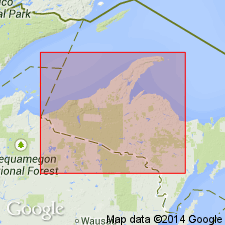
- Usage in publication:
-
- East Branch arkose*
- Modifications:
-
- Named
- Dominant lithology:
-
- Arkose
- Conglomerate
- AAPG geologic province:
-
- Lake Superior region
Summary:
Pg. 30 (table 1), 31-32. East Branch arkose, basal formation of Dickinson group (new). Consists of arkose, arkosic conglomerate, and interbedded metamorphosed basalt flows and basic tuffs; beds are steeply dipping or vertical. Basal conglomeratic beds contain deformed pebbles, many of which are quartzite or rock fragments identical to underlying granite gneiss. Thickness in type area about 1,000 feet. Underlies Solberg schist (new). Actual contact with older granite gneiss not observed, though in some places the two rock units are exposed but a few feet apart. Strata have been referred to as Sturgeon quartzite by earlier workers who assumed it to underlie Randville dolomite that is exposed a short distance to the north. Age is early Precambrian (pre-Animikie). Report includes stratigraphic sequence chart.
[Considered type area]: well exposed in broad glacially polished outcrops in secs. 17 and 18, T. 42 N., R. 28 W., along East Branch of Sturgeon River, Dickinson Co., Northern Peninsula, northwestern MI (Lake Superior region). Named from East Branch.
Source: US geologic names lexicon (USGS Bull. 1200, p. 1201); supplemental information from GNU records (USGS DDS-6; Denver GNULEX).
For more information, please contact Nancy Stamm, Geologic Names Committee Secretary.
Asterisk (*) indicates published by U.S. Geological Survey authors.
"No current usage" (†) implies that a name has been abandoned or has fallen into disuse. Former usage and, if known, replacement name given in parentheses ( ).
Slash (/) indicates name conflicts with nomenclatural guidelines (CSN, 1933; ACSN, 1961, 1970; NACSN, 1983, 2005, 2021). May be explained within brackets ([ ]).

